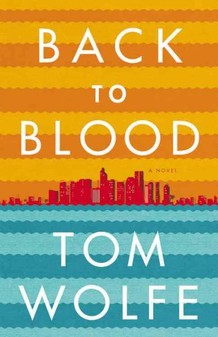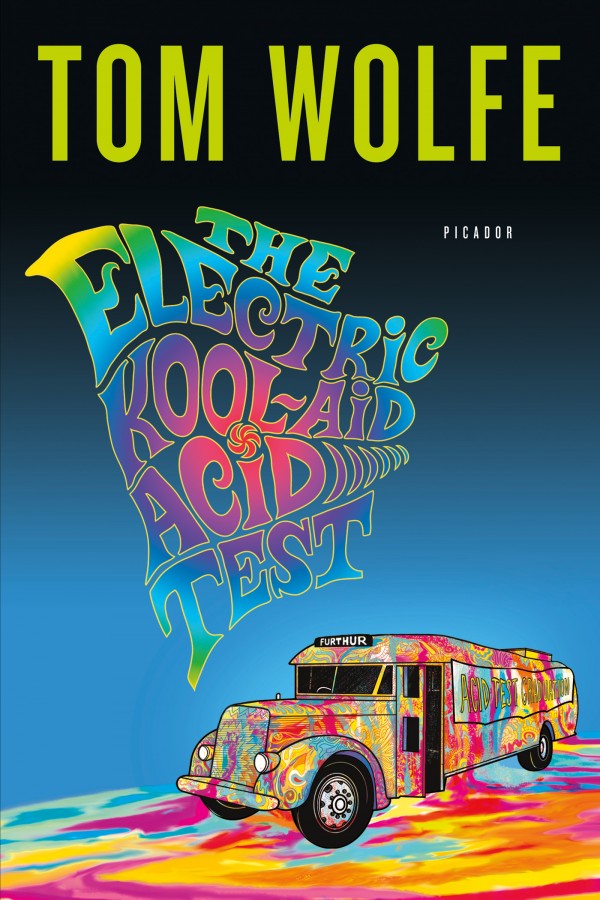The Electric Kool-Aid Acid Test (Bantam, 1968, reprinted 1999)
 BY MAVIS LINNEMANN BOOK CRITIC You’re either on the bus, or off the bus, Ken Kesey chants. On the bus. Off the bus. With the Merry Pranksters. Or with the squares. On the bus. Off the bus. This phrase — a meaty reality bite all by itself, repeated like a mantra throughout the book — marks the metaphysical divide that is at the center of Tom Wolfe’s raw account of the psychedelic counterculture in The Electric Kool-Aid Acid Test, the legendary New Journalism chronicle of Ken Kesey (author of One Flew Over the Cukoo’s Nest) and the Merry Pranksters’ efforts blow America’s collective mind. The book has become a must-read for anyone interested in drug culture and late 20th Century American history. It’s where most people go after Catcher In The Rye.
BY MAVIS LINNEMANN BOOK CRITIC You’re either on the bus, or off the bus, Ken Kesey chants. On the bus. Off the bus. With the Merry Pranksters. Or with the squares. On the bus. Off the bus. This phrase — a meaty reality bite all by itself, repeated like a mantra throughout the book — marks the metaphysical divide that is at the center of Tom Wolfe’s raw account of the psychedelic counterculture in The Electric Kool-Aid Acid Test, the legendary New Journalism chronicle of Ken Kesey (author of One Flew Over the Cukoo’s Nest) and the Merry Pranksters’ efforts blow America’s collective mind. The book has become a must-read for anyone interested in drug culture and late 20th Century American history. It’s where most people go after Catcher In The Rye.
The Pranksters began as a small colony of pharmacological Magellans based in Northern California as Kesey, with all his charisma and inexplicable magnetism, amassed a swelling cult of friends and followers who shared his vision of an enlightened collective consciousness achieved by taking acid. The Merry Pranksters, as they soon called themselves, experimented not only with LSD, but also with sound equipment, video and improvisation to create a whole new breed of sound — acid rock. Hell, the Grateful Dead used to play their acid parties, back when they were still called the Warlocks. The best moments of the book are when they take the party mobile, zig-zagging woozily across the country in a Day-Glo bus, staging large-scale Acid Tests, fucking with the squares, and, above all things, spreading the acid love. Like any good acid trip, Electric Kool-Aid is both illuminating and cosmically confusing, blessedly so. The book jumps erratically between time periods, highlighting the grassroots acid movement’s changes in socio-political attitude, mindset and pecking order as it morphs from a small, select conspiracy to a nationwide phenomenon with far-reaching consequences both great and terrible. But it’s the experience, not the plot, that Wolfe wants the reader to walk away with.
In the course of the 400+ pages, Wolfe never really passes judgment on his subjects, though his fascination with them is obvious. And although Wolfe attended many of the Prankster’s festivities, he never includes himself in the action. I can’t help but wonder if Wolfe ever drank the Kool-Aid, because the novel is a trip in and of itself. Wolfe used his own experiences with the Pranksters, video footage, recordings and Hunter S. Thompson’s personal tapes of the Hell’s Angels, in order to recreate the birth of the psychedelic era — and the effect is an aptly distorted but remarkably tangible odyssey through amorphous looking glass of the LSD culture.

![]() RELATED: Tom Wolfe wrote his new novel, Back to Blood, entirely by hand. But the author of The Electric Kool-Aid Acid Test and The Bonfire of the Vanities also says that wasn’t entirely by choice — he’d rather have used a typewriter. “Unfortunately, you can’t keep typewriters going today — you have to take the ribbons back to be re-inked,” Wolfe tells Fresh Air‘s Dave Davies. “There’s a horrible search to try to find missing parts.” Back to Blood is set in Miami, which Wolfe describes as the only city where an immigrant community rose to dominate the political landscape in just over a generation. The novel deals with racial and ethnic conflict among the city’s diverse inhabitants, including immigrants from Cuba, Haiti and Russia, as well as the city’s long-established African-American and Anglo communities. Its central character, the young Cuban-American police officer Nestor Camacho, struggles with his identity and the ire of his community after safely bringing a Cuban refugee down from the top of a ship’s mast and arresting him before he could set foot on American soil. MORE
RELATED: Tom Wolfe wrote his new novel, Back to Blood, entirely by hand. But the author of The Electric Kool-Aid Acid Test and The Bonfire of the Vanities also says that wasn’t entirely by choice — he’d rather have used a typewriter. “Unfortunately, you can’t keep typewriters going today — you have to take the ribbons back to be re-inked,” Wolfe tells Fresh Air‘s Dave Davies. “There’s a horrible search to try to find missing parts.” Back to Blood is set in Miami, which Wolfe describes as the only city where an immigrant community rose to dominate the political landscape in just over a generation. The novel deals with racial and ethnic conflict among the city’s diverse inhabitants, including immigrants from Cuba, Haiti and Russia, as well as the city’s long-established African-American and Anglo communities. Its central character, the young Cuban-American police officer Nestor Camacho, struggles with his identity and the ire of his community after safely bringing a Cuban refugee down from the top of a ship’s mast and arresting him before he could set foot on American soil. MORE

